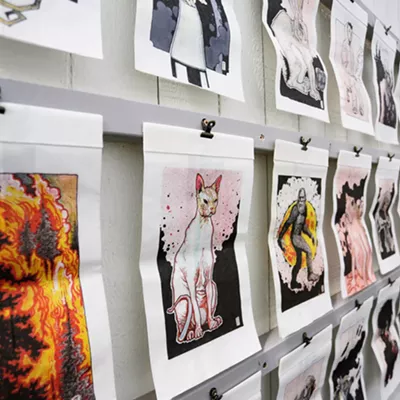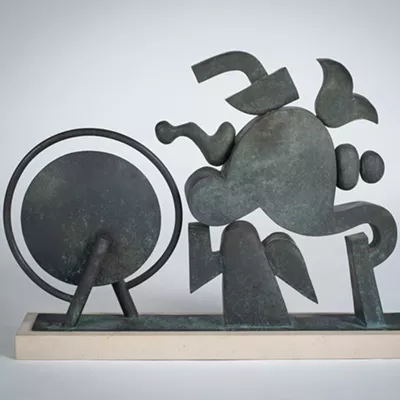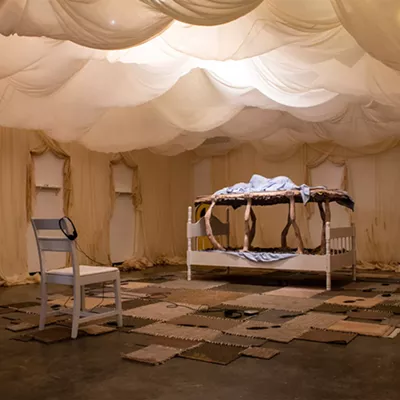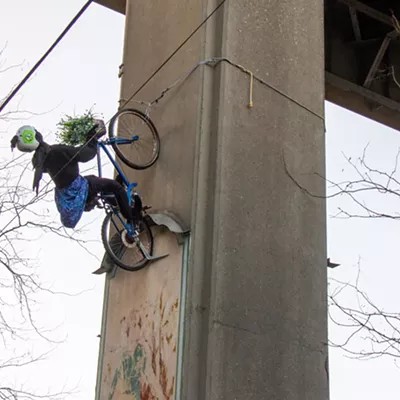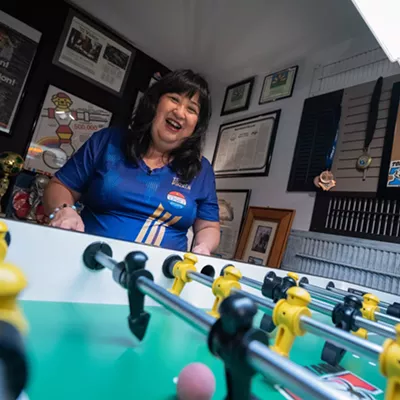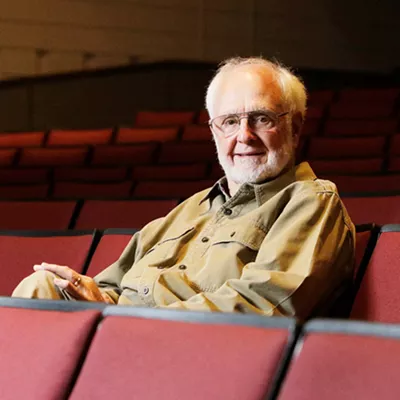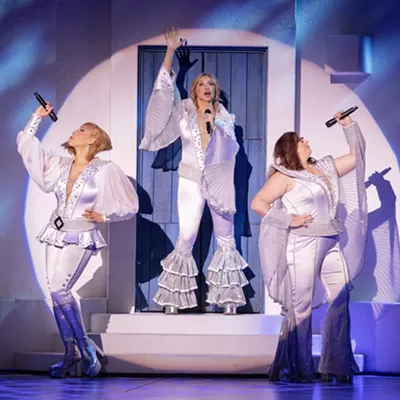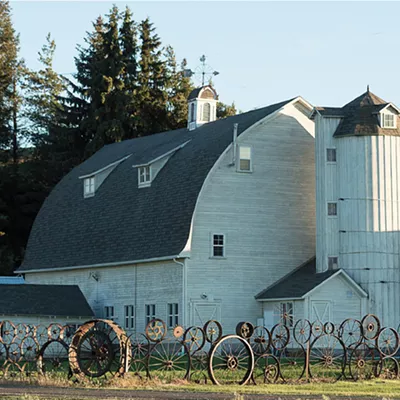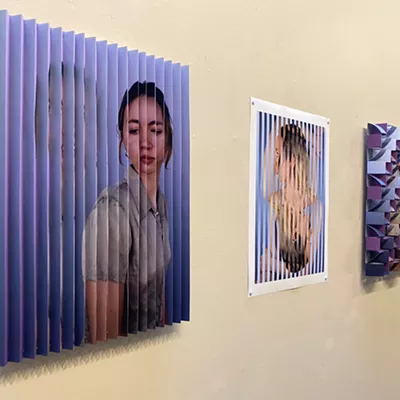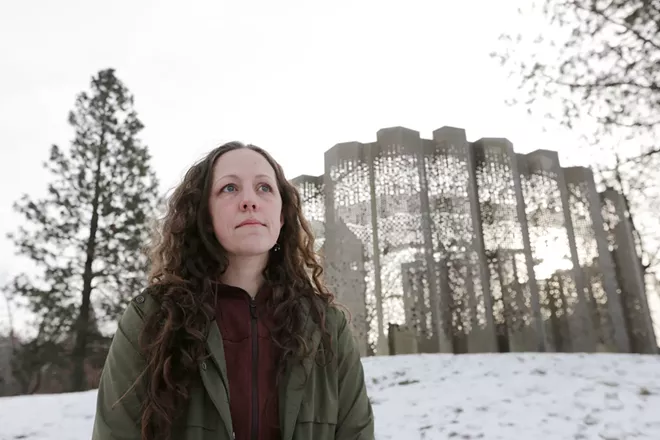
Marketing materials for a unique Post Falls storage complex promote the "man cave" appeal of its individual spaces, some of them as large as 25-by-50 feet with a 14-foot roll-up door. They're big enough to park your deluxe motorhome, boat or other luxury "toy," but for artist Sarah Thompson Moore, the cavernous space means one thing: work.
Her current projects include a mosaic of colorful glass and rock for a huge floor mural she'll transport to Seattle for the Alki Beach Pump Station 38 improvement project. Once installed, the mosaic will convey local topography and its historical significance to the Muckleshoot and Suquamish Tribes.
"I think I have really been pulled to public work because it's site specific," says Moore, a Coeur d'Alene-based visual artist who created Riverfront Park's The Seeking Place, installed in October 2022.
"Every site is a new set of parameters, not only just physically — what you can do there — but the history of the site, the context of the place that it's in, the people in that area."
Inspired by both basalt columns and the sculpture's intended location on a rise along the Howard Street Promenade, The Seeking Place features perforated metal panels, some as high as 12 feet, which Moore fabricated inside her Post Falls studio.
Metal isn't Moore's only area of expertise. Her cast concrete piece titled Ex Vetere is located on the Whitworth University campus, and she's also working with concrete for an exhibition opening this month at North Idaho College titled "Vestiges."
For the NIC show, she's creating several circular, concrete forms to hang on the wall. They're visually united by color, says Moore, who is slated to talk about her work on Tuesday, Feb. 14, from noon to 1 pm at Todd Lecture Hall.
"I want people to be able to take from them the idea of these being something that could spark some curiosity about where this object came from, or that it's kind of a precious object [that] we don't really know what made it," Moore says.
Moore grew up in Oregon in a family that camped, fished and enjoyed that state's natural abundance, but also exposed her to unconventional art forms.
"I had some opportunities [to create art] with the family sign business in Oregon, where my grandpa was a sign painter and pinstriper," Moore says. She also remembers the giant metal birds and animals she saw on a visit to an Oregon bronze foundry where her uncle worked.
When she was 12, Moore's family relocated to Coeur d'Alene, where she attended public school intent on pursuing art. Several mural projects — working larger was becoming a trend for her — and winning the VFW Auxiliary's Young American Creative Patriotic Art Contest were pivotal, the latter earning her a scholarship.
"That's how I was able to study in Italy for a little while, so that was a big deal for me at the time," says Moore, who was impressed by its architecture, especially ancient Rome's Pantheon and Colosseum.
In 2005, Moore returned to North Idaho and got a job at the former Cire-Perdue Casting bronze foundry in Hayden, where she worked for three years.
"At that point, I stopped school and made that my education," says Moore, who immersed herself in casting, which involves making a mold of something (called a negative) into which is poured molten-hot metal to create the positive form — a duplicate of the original item.
In 2010, Moore interned with Montana-based ceramic artist Beth Cavener, earning her a mention in Cavener's 2019 book, Human, and a vision of life as an artist.
"She's the main person that inspired me as to really what a working artist looks like," Moore says.
Moore applied to the venerable Pennsylvania Academy of the Fine Arts, America's first art school dating to 1805.
"It was very skill-based still, and I was interested in that, but I saw that they were also sort of pushing working conceptually as well," Moore says. "So I felt like it'd be a good balance for me, of where I came from and where I wanted to go."
While on the East Coast, Moore joined a fellowship program at the prestigious Art Students League called Model to Monument, which partnered with the New York City Department of Parks and Recreation to train artists in creating public artworks. Completing several large-scale works, including a Bronx-based collaborative piece titled Windtower that eventually got installed in Florida, was another pivotal experience.
That experience, says Moore, more so than selling her artwork, reinforced her sense that she was an artist.
In 2016, Moore returned to Coeur d'Alene and began building her studio practice. She's also dreaming big, looking forward to experimenting with new materials and pushing boundaries with things she's already worked with, like the anodized aluminum she used in The Seeking Place. She also wants to explore more architecturally inspired artwork, perhaps even a livable piece.
"Who knows?" she asks. "The sky's the limit. I like that freedom to explore." ♦
Sarah Thompson Moore: "Vestiges" • Feb. 14-March 24; open Mon-Thu from 10 am-4 pm, Fri from 10 am-2:30 pm • Free • North Idaho College, Boswell Hall Corner Gallery • 1000 W. Garden Ave., Coeur d'Alene • nic.edu



